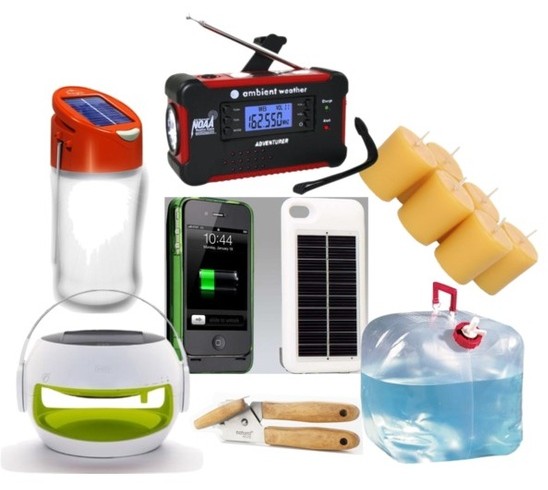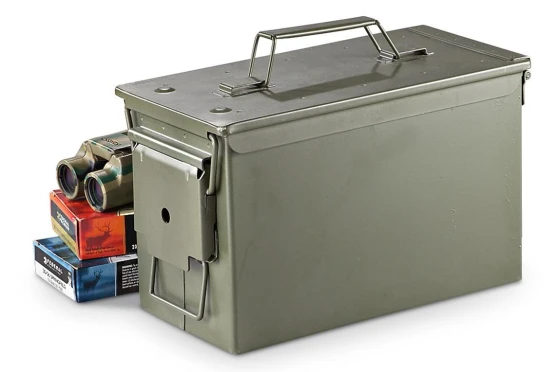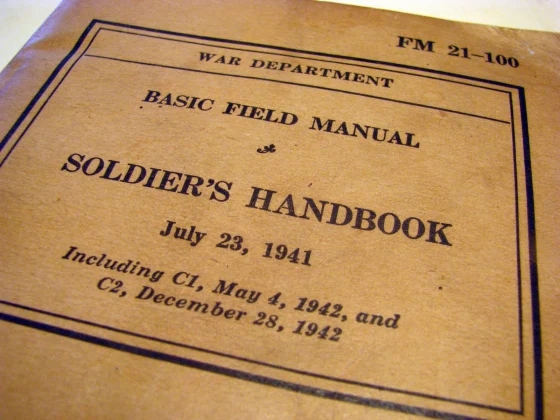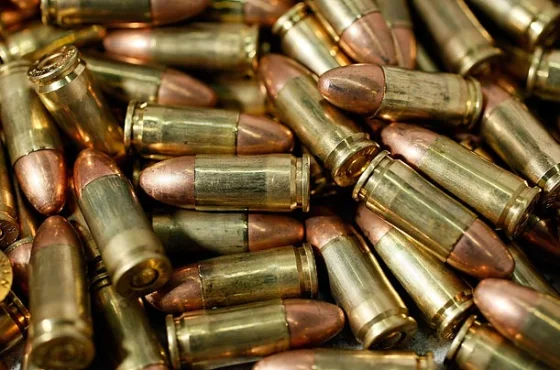
Pictured left to right: 7.62x39mm Soviet, 5.45x39mm Soviet, 7.62x51mm NATO, 5.56x45mm NATO.
“Buy it cheap! Stack it deep!”
-Savannah Arsenal-
Contents:
- 5.56x45mm NATO / .223 Remington
- 5.45x39mm Soviet
- 7.62x39mm Soviet
- 7.62x51mm NATO and .308 Winchester
- Steel Case Ammunition
- Bi-Metal Bullets and Barrel Wear
5.56x45mm NATO / .223 Remington:
General Information:
- Wikipedia’s 5.56x45mm NATO page
- Wikipedia’s .223 Remington page
- Seen far right in the photo above.
Weapons That Fire 5.56x45mm NATO Ammunition include:
- AR-15 / M-4
- Tavor TAR-21
- Sig 556
- Mini-14 (older models use .223 Remington)
- and even a few AK-47s.
Difference Between .223 Remington and 5.56mm NATO:
- .223 Remington: One of the most popular rifle cartridges among American shooters. Optimized for flat shooting accuracy. It is intended for precision shooting and varmit hunting applications. Can be used in 5.56mm chambers and barrels. While similar to NATO-standardized 5.56x45mm ammo, .223 Remington and 5.56mm NATO rounds are not identical, so be sure you’re shooting the appropriate caliber in your firearm.
- 5.56mm NATO: Optimized for reliability (military). It is loaded at a much higher chamber pressures than the .223 Remington, and the pressure is too high for .223 Remington chambers and barrels. A 5.56x45mm NATO round will fit in and fire from a firearm intended to use .223 Remington ammunition, but its higher chamber pressures will damage, or at least cause premature wear on the firearm.
- It is safe to shoot .223 Remington out of a 5.56mm barrel, but you shouldn’t shoot 5.56mm out of a .223 barrel.
5.56mm NATO Military Ammo Designations:
- XM193: 5.56×45mm 55-grain ball cartridge.
- XM196: 5.56×45mm 54-grain tracer cartridge, red cartridge tip.
- XM855: 5.56×45mm 62-grain FN SS109 ball cartridge, green tip w/steel penetrator and a lead core.
- XM856: 5.56×45mm 64-grain FN L110 tracer cartridge.
- XM262: 5.56×45mm 77-grain Open-Tipped Match/Hollow-Point Boat-Tail cartridge. Mod 0 features Sierra Matchking bullet, while Mod 1 features either Nosler or Sierra bullet.
XM193 5.56mm 55-Grain Ammunition Packaging:

- XM193: 5.56mm, 20-round brown box, 500-rounds per case.
- XM193BK: 5.56mm, loose bulk, 1000 rounds per case. Not as pretty as the boxed stuff where some rounds may have small dents, but still goes bang.
- XM193A and XM193AF: 5.56mm, rounds packed in ten-round stripper clips, 900 rounds per case.
- XM193C: 5.56mm, commercial package, American Eagle Tactical “Black Box”, 20-round box.
- XM193CBP: 5.56mm, commercial package, American Eagle Tactical “Black Box”, loose rounds in 200 round bulk (value) pack.
- XM193F: Packaging for XM193 is now done at Federal’s ammunition plant in Anoka, Minnesota, so a new part number, XM193F, was needed for FET purposes. This is the same ammunition as XM193 and XM193C and apparently replaces both of these items.
back to top
5.45x39mm Soviet:
General Information:
- Wikipedia’s 5.45x39mm Soviet page
- 5.45x39mm Soviet (second from left in the photo at the top of the page) is a bottlenecked cartridge without a rim that was developed in the mid-1970’s by the Soviet Union. Looking for a light-weight, fast projectile, 5.45x39mm became a favorite among militaries in the former Eastern Bloc.
- Today’s shooters will find most 5.45x39mm Soviet is produced in the former Soviet Union, Bulgaria, Poland, and other former communist nations.
Weapons that fire 5.45x39mm Soviet include:
- AK-74,
- A few AR-15 manufacturers make AR-15 rifles chambered for this cartridge.
Golden Tiger 5.45x39mm:
5.45x39mm Ammunition Comparison:
back to top
7.62x39mm Soviet:
General Information:
- Wikipedia’s 7.62x39mm Soviet page
- 7.62x39mm Soviet (far left in the photo at the top of the page) was initially designed during World War II for use in the SKS Carbine. Today, 7.62x39mm Soviet rounds are most commonly fired by AK-47 shooters at the range, used by some North American hunters in the field, and still relied upon for military use in China, North Korea, Venzuela, and Finland.
Weapons that fire 7.62x39mm Soviet include:
7.62x39mm Bullet Expansion — Soft Point vs. Hollow Point vs. FMJ:
Golden Tiger 7.62x39mm:
Wolf Military Classic 7.62x39mm — FMJ & JHP:
7.62x39mm Ammunition Comparisons:
back to top
7.62x51mm NATO and .308 Winchester:
“7.62x51mm battle rifles are the best way to let people know that what they thought was cover is only concealment.”
– Author unknown –
General Information:
- Wikipedia’s 7.62x51mm NATO page
- Wikipedia’s .308 Winchester page
- Seen second from the right in the photo at the top of the page.
- More soon!
Weapons that fire 7.62x51mm NATO include:
- H&K G3 / PTR-91 / CETME
- M1A / M-14
- FAL
- M-240 Machine Gun
- M-60 Machine Gun
- M-134D Minigun
- HK-21 Machine Gun
Differences Between 7.62x51mm NATO and .308 Winchester:
7.62x51mm NATO and .308 Winchester are names that are often used interchangeably, and although they look similar, the chart to the right shows that they are slightly different. 7.62x51mm NATO is a military round and is intended for MBRs (Main Battle Rifle) and MGs (General Purpose Machine Gun). The civilian .308 Winchester, which is commonly used in hunting and precision bolt-action rifles, has as much as 24% more chamber pressure than the 7.62x51mm NATO cartridge. While the .308 Winchester will fit and fire from a firearm intended for 7.62x51mm, it may sooner or later damage that firearm. Summary: It is okay to shoot either round from your bolt-action rifle that is chambered .308 Winchester, but only fire 7.62x51mm ammunition from firearms that are chambered for that round (military style rifles).
Important note: When dealing with military 5.56x45mm NATO and civilian .223 Remington ammunition the military 5.56x45mm has much more pressure than the civilian ammunition. With the 7.62x51mm NATO / .308 Winchester comparison the civilian ammunition is the more powerful. Be careful not to get the relationship confused.
7.62x51mm NATO Barrier Penetrating Capability:
back to top
Steel Case Ammo:
Steel Case Ammo in the AR-15:
 The clerk in the sporting goods section of you local Wally World told you not to buy the less expensive Russian/Ukrainian manufactured, steel-case, bi-metal bullet ammunition because it is dirty and will wear out your guns. The guy working in a retail store doesn’t have any idea of what he is talking about. Or does he?
The clerk in the sporting goods section of you local Wally World told you not to buy the less expensive Russian/Ukrainian manufactured, steel-case, bi-metal bullet ammunition because it is dirty and will wear out your guns. The guy working in a retail store doesn’t have any idea of what he is talking about. Or does he?
In the mid 1990s I purchased a 1000 round case of Wolf brand, Russian manufactured, steel case 9mm 115 grain FMJ ammo. It was lacquer coated so as to keep it water proof, protect it during long-term storage, and keep the steel cases from rusting. I bought it with the intention of shooting from my new gen 2.5 Glock 26. In those golden days of cheap ammunition I was known to blow through it pretty fast. My guns stayed hot. While my Glock would eat anything with a brass case, I couldn’t even make it through a single 50 round box without the lacquer melting off the cases and causing them to stick in the chamber and not eject. The only way to get the empty cases out was to lock the slide back and pop the stuck empty out with a cleaning rod inserted through the muzzle. I had to use a brass chamber brush and scrub and scrub to get the chamber clear of all of the lacquer build up so that the gun would function again. I then had 950 rounds of shitty ammo and didn’t know what to do with it. Eventually one of our other members and I ran all 950 rounds through a Class-3 H&K MP5. The sub-gun shot every round full-auto without a single hiccup. It was filthy afterwards. I didn’t have to clean it, but I’m sure that who ever had to scrub 950 rounds worth of lacquer was pissed!
Fast forward to present day: Only Russian made “Brown Bear” labeled ammunition still has a lacquer finish. You can usually only find it in 7.62x39mm and 5.45x39mm, both of which are Kalashnikov rounds. (AK’s don’t care what you shoot out of them and will eat most anything.) Wolf and Tula do not lacquer any more. I have fired thousands of round of the modern Wolf and Tula ammunition out of my ARs, AKs, and Glocks. It always functions in my guns and is perfect for target practice.
Addendum: This past year I took James Yeager’s two-day Fighting Pistol and two-day Fighting Rifle class. See Tactical Response’s Fighting Pistol and Fighting Rifle Courses: After Action Report. We were told that it would be okay to use steel-case Russian Ammunition in our Glocks pistols and Kalashnikov style rifles, but they insisted that we use brass-case ammunition in our AR style rifles. Evidently steel case ammunition expands and can swell and stick in hot AR chambers. During the four days of class I fired 975-rounds of 9mm steel case ammunition from a Glock 17 without any maintenance or additional lubrication and it ran without any malfunctions. My brother and I each ran 1300 rounds of brass-case 5.56mm without a single hiccup. One student still used steel-case ammunition in their AR and suffered stuck cases when the weapon became very hot.
Conclusion: You can shoot steel-case ammunition out of a hot and dirty Glock or Kalashnikov style firearm. AR rifles are more finicky, and while most of them will digest steel-case ammunition for casual plinking, you will want to use brass-case ammunition for serious class-time and self-defense applications. You will have to thoroughly test any other firearm to verify its performance with steel-case ammunition when it is hot and dirty. Make sure that you have a cleaning rod to remove stuck cases.
Epic Torture Test:
 Lucky Gunner Lab’s “Brass vs. Steel Cased Ammo – Epic Torture Test” These guys use four identical AR-15 rifles and fire 10,000 rounds of Federal brass case ammo, 10,000 rounds of Wolf steel case ammo, 10,000 of Tula steel case ammo, and 10,000 rounds of Brown Bear steel case ammo. Throughout the 10,000 rounds of each type of ammo they test for accuracy, velocity, throat erosion, and chamber pressure. Their results may further challenge your opinions.
Lucky Gunner Lab’s “Brass vs. Steel Cased Ammo – Epic Torture Test” These guys use four identical AR-15 rifles and fire 10,000 rounds of Federal brass case ammo, 10,000 rounds of Wolf steel case ammo, 10,000 of Tula steel case ammo, and 10,000 rounds of Brown Bear steel case ammo. Throughout the 10,000 rounds of each type of ammo they test for accuracy, velocity, throat erosion, and chamber pressure. Their results may further challenge your opinions.
Will Steel Case Ammo Damage Your AR-15 Extractor?
Below are some YouTube videos that I’ve collected on the subject of whether steel case ammunition will damage the extractor in your AR-15, and if the bi-metal bullets found in some of the Russian and Ukrainian ammunition will damage your barrel.



































